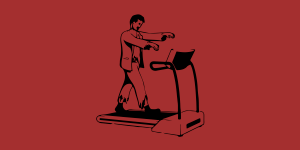Code and Fitness: Fear the Walking Dev

I've been sitting in front of code and text for the good part of the last 15 years. A sedentary job can take its toll on your health, especially as you begin to age and your body is past the "thank you sir, may I have another" phase.

They're not wrong when they say sitting is the new smoking. Most people - even those with extraordinarily expensive anatomic chairs - find ways to distort their sitting position and twist their back after a mere hour of sitting, let alone eight. Add to that more sitting at home when you return from work, and it becomes a truly scary thought.
The perils of sitting too much are well documented, but what very few standing desk proponents will tell you is that standing can be even worse. When coupled with sitting, it is of course better than sitting all the time, but standing for prolonged periods of time will seriously injure your back, shoulders, and neck, depending on the anatomical setup of your standing desk.
The pain you feel after standing for a while is not good-fatigue pain you get from working out. It's not "the burn". Those extra 50 kcal you burnt standing up aren't making your muscles sore with progress. It's your lumbar back screaming for some proper support, because your legs are too weak and your back muscles too atrophied to support your upper body weight for hours without help.
In short, prolonged uninterrupted standing is less healthy than sitting for the same period of time.
But you can Google around for research on this, there's plenty. I want to take the following few paragraphs to tell you how I got around this and how you can regain or maintain your health if you're like me and like to eat sweet things very very much and have almost no self control.
Origin
Back when I was a web dev for a publishing house in 2010, I would be sitting in an office all day and eat pastries from a bakery three times a day as I passed it by. It got to the point where I almost killed myself eating.
Fun times they were not.
At 100kg, I quit my job to survive. To this day, there is no amount of money which would make me work from an office again, both for physical and for mental health (the commutes would send me into barbarian rages, apart from wasting one to two hours of my unrefundable time per day).
I did some research, tested some things, and a year later I was 30kg lighter, 1kg probably being the hair.
Fast forward another 7 years and sure, I've had my ups and downs (having a kid in particular causes 6 months of no sleep to the degree of not having energy to live, let alone exercise), but I found a technique which lets me lose weight reliably and keep it off.
I won't go into details on speed-losing it because that's not maintainable for most people (mainly it entails a lot of running, some weights, and a change of diet in addition to the Miracle Cure™ for 4x progress), but the general approach outlined below will increase your daily kcal budget by 2000, which is roughly 6 donuts or a big pizza. That's in addition to your default kcal spend, which means you can maintain your weight on around 3500-4000 kcal a day, without gaining or losing a gram.
The Miracle Cure™
So what is it?
Quite simply: get a treadmill desk and work 4 hours a day on it at maximum incline with lowest speed.
That's all there is to it.
Just another day in the office 🤷♂️ pic.twitter.com/u5Yni6pavz
— Bruno Skvorc (@bitfalls) March 12, 2019
One hour on a treadmill with max incline is around 4000 steps and 400 calories (a little less for women). Depending on what speed you can adapt to, maybe even more.
I make 20k steps per day which sounds like a lot, but when you consider that a simple one hour dog walk is 5000-6000 steps alone, another 3 hours out of 8 working hours per day behind a treadmill desk isn't really that much. It can only be a problem if it's not part of your culture (i.e. Americans do only 5-7k steps per day), but it doesn't take long to get used to it. How much do you think I walked in that first picture above?
Apart from not having to change anything at all about your diet (keep your cupcakes if you want them, I do!), this has the nice side effect of making your drink a LOT of water. I'll end a day with 4 liters of consumed water, easily.
But what about...
... the noise?
Most modern electical treadmills are silent unless you run on them. In walk mode, you can barely hear the hum and steps outside the room you're in, let alone into a neighboring apartment.
... the cost?
It's really cheap. You can get a used treadmill for $500 on your local version of craigslist, put a plank over the handles, and you're golden. Dedicated treadmill desks are the dumbest thing, just use a treadmill. This was my initial version all those years ago.
... the sweat / pain?
Yes, you will sweat. Especially if you follow my advice and walk on an incline. Do not do this in an office environment or coworking space without several sets of spare clothes. Your feet may hurt if you overdo it, but just take it easy and work up to it. To avoid neck and shoulder pain, put a monitor at eye level and a fair distance (see my pic above with baby), and get a split keyboard (same pic) so you can type with your hands apart - this relaxes your shoulders instead of having you slouch.
... the precision?
It takes around 2 weeks to get used to using the mouse and keyboard while walking. You're not useless during this period, just a little slower. Obviously, the heavier (more stable) the treadmill, the less wiggling you'll have and the sooner you'll get used to it.
... the concentration?
You don't lose any after the initial two weeks. I hardly notice I'm walking when I'm really deeply invested in a task. In fact, if you're prone to procrastination when sitting, this will occupy that idle part of your brain and you'll actually be MORE productive while walking.
In conclusion, maintaining health while working a computer-focused job isn't as impossible as many make it out to be. No need to change your diet (unless it's really a wreck, like ONLY sweets all the time) or workout habits - just walk.
If you want to learn more, have questions or comments, hit me up on Twitter.




Comments